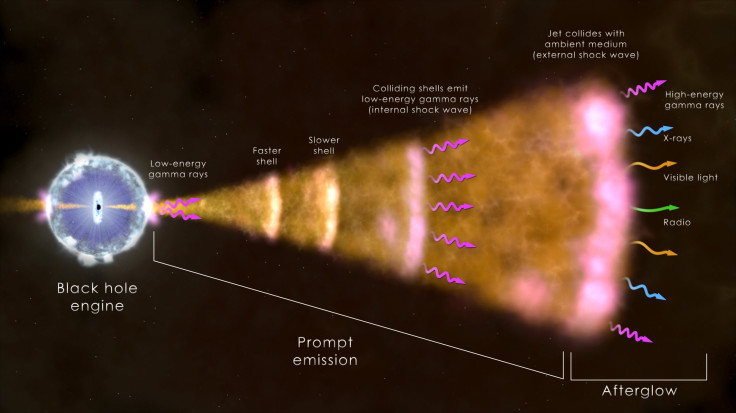Massive Cosmic Explosion Challenges Current Understandings Of Gamma-Ray Bursts

A blast of light triggered by a dying star has compelled astronomers to rethink what they know about how gamma-ray bursts work, NASA said at an event on Thursday. The space agency considered the gamma ray burst to be one of the brightest cosmic explosions ever seen.
Gamma rays from the explosion, designated GRB 130427A, were captured by three NASA satellites in April, and they became the focus of many astronomers around the world. According to scientists, gamma-ray bursts are thought to be produced when the core of a massive star dies and forms a black hole, which then drives jets of particles, which drill all the way through the collapsing star and erupt into space at nearly the speed of light.
“We expect to see an event like this only once or twice a century, so we're fortunate it happened when we had the appropriate collection of sensitive space telescopes with complementary capabilities available to see it,” Paul Hertz, director of NASA's Astrophysics Division in Washington, said in a statement.
According to scientists, gamma-rays are the most energetic form of light. They generally contain energies in the million-electron-volt (MeV) range, or nearly 500,000 times the energy of visible light. However, the most energetic emission could hold even billion-electron-volt (GeV) gamma rays.
The Gamma-ray Burst Monitor, or GBM, aboard NASA's Fermi Gamma-ray Space Telescope, captured the initial wave of gamma rays from GRB 130427A shortly after 3:47 a.m. EDT April 27. In its first three seconds alone, the "monster burst" proved brighter than almost any burst previously observed.
NASA's Swift Gamma-ray Burst Mission, launched in 2004, detected the burst almost simultaneously with the GBM and quickly relayed its position to ground-based observatories, which subsequently detected an optical flash that peaked at magnitude 7 on the astronomical brightness scale, easily visible through binoculars. According to astronomers, it was the second-brightest flash ever seen from a gamma-ray burst.
Just as the optical flash peaked, Fermi's Large Area Telescope, or LAT, detected a spike in GeV gamma-rays reaching 95 GeV, the most energetic light ever to be witnessed from a burst.
"We thought the visible light for these flashes came from internal shocks, but this burst shows that it must come from the external shock, which produces the most energetic gamma-rays," Sylvia Zhu, a Fermi team member at the University of Maryland in College Park, said.
The LAT detected GRB 130427A for about 20 hours, far longer than any previous burst. The light from the blast traveled 3.8 billion years before arriving at Earth.
© Copyright IBTimes 2024. All rights reserved.






















